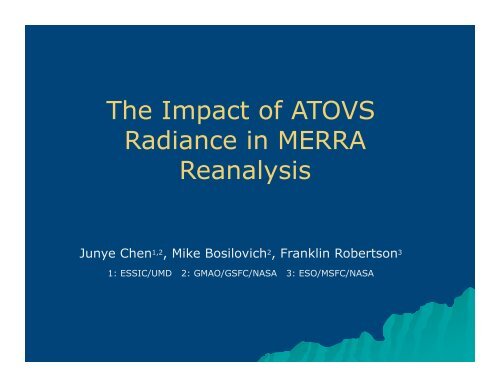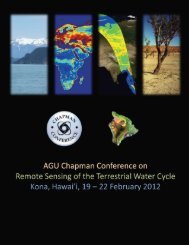The Impact of ATOVS Radiance in MERRA Reanalysis
The Impact of ATOVS Radiance in MERRA Reanalysis
The Impact of ATOVS Radiance in MERRA Reanalysis
- No tags were found...
You also want an ePaper? Increase the reach of your titles
YUMPU automatically turns print PDFs into web optimized ePapers that Google loves.
<strong>The</strong> <strong>Impact</strong> <strong>of</strong> <strong>ATOVS</strong><strong>Radiance</strong> <strong>in</strong> <strong>MERRA</strong><strong>Reanalysis</strong>Junye Chen 1,2 , Mike Bosilovich 2 , Frankl<strong>in</strong> Robertson 31: ESSIC/UMD 2: GMAO/GSFC/NASA 3: ESO/MSFC/NASA
Contents <strong>The</strong> idea <strong>of</strong> reanalysis was <strong>in</strong>itiated for climate changestudy, but the <strong>in</strong>homogeneity issue <strong>of</strong> reanalysisimpedes the full realization <strong>of</strong> this goal. <strong>The</strong> new NASA reanalysis (<strong>MERRA</strong>), and ongo<strong>in</strong>gefforts to m<strong>in</strong>imize the <strong>in</strong>homogeneity <strong>in</strong> <strong>MERRA</strong>. <strong>The</strong> impact <strong>of</strong> NOAA-15 <strong>ATOVS</strong> <strong>in</strong> <strong>MERRA</strong>.
At the Beg<strong>in</strong>n<strong>in</strong>g, the Idea <strong>of</strong> <strong>Reanalysis</strong> was Initiatedfor Climate Change Study:“to use a frozen state-<strong>of</strong>-the-art analysis/forecast system andperform data assimilation us<strong>in</strong>g past data” (Kalnay et al. 1996),thus “to produce <strong>in</strong>ternally consistent, homogeneous,multivariate data sets for the earth's climate system. … and suchdata sets will be quite useful for study<strong>in</strong>g global climatechange” (Bengtsson and Shukla 1988). A fixed assimilation systemelim<strong>in</strong>ates the <strong>in</strong>homogeneity caused by analysis/model change.
Ideally, if both observation and model simulation arenot biased, random errors will be m<strong>in</strong>imized by theanalysis scheme, and there will be no artificial climatetrend <strong>in</strong> the reanalysis data.In reality, both observation and model are more orless biased. As the global observ<strong>in</strong>g system changesalong the time, the reanalysis homogeneity is hard tobe kept, even with fixed model and analysis scheme.
Features <strong>in</strong> the NASA <strong>MERRA</strong> reanalysis toDecrease the Side Effect <strong>of</strong> Observ<strong>in</strong>g System Incremental Analysis Updates (IAU) to slowly adjustthe model states toward the observed state. Adaptive Biases Correction to keep temporalhomogeneity <strong>in</strong> each observation type. Us<strong>in</strong>g homogenized radionsonde data fromHaimberger (2007).But the impact <strong>of</strong> the <strong>in</strong>troductions <strong>of</strong> New ObservationPlatforms was not addressed.
<strong>The</strong> impact <strong>of</strong> chang<strong>in</strong>g observ<strong>in</strong>g system <strong>in</strong> reanalysesNOAA15(<strong>ATOVS</strong>)NOAA16(<strong>ATOVS</strong>)Cease <strong>of</strong>TOVS (?)SSMI
Radiosonde, PIBAL w<strong>in</strong>d, aircraft report, dropsonde, surface land observationPre-sat era stream (PRES)Reduced observ<strong>in</strong>g system segment (ROSS) 1GMS & METEOSAT cloud drift w<strong>in</strong>d, ship & buoy observationPAOBTOVS<strong>MERRA</strong> stream 12SSM/I3Sp<strong>in</strong>up 1ERS surface w<strong>in</strong>dW<strong>in</strong>d pr<strong>of</strong>iles<strong>MERRA</strong> stream 24GOES cloud drift w<strong>in</strong>dTMI ra<strong>in</strong>5<strong>ATOVS</strong> (NOAA-15)QuikSCAT surface w<strong>in</strong>d6<strong>ATOVS</strong> (NOAA-16)GOES SoundersSp<strong>in</strong>up27MODIS w<strong>in</strong>dAIRS<strong>MERRA</strong> stream 370 71 72 73 74 75 76 77 78 79 80 81 82 83 84 85 86 87 88 89 90 91 92 93 94 95 96 97 98 99 00 01 02 03 04 05 06 07 08 09 10 11 12
ROSS 1 7Pre-sat era stream <strong>MERRA</strong> stream 1 <strong>MERRA</strong> stream 2 <strong>MERRA</strong> stream 3 Patch 1: to correct TOVS etc. impact Patch 2: to correct SSM/I impact Patch 3: to correct scatterometer surface w<strong>in</strong>d impact Patch 4: to correct GEOS cloud drift w<strong>in</strong>d impact Patch 5: to correct <strong>ATOVS</strong> (NOAA 15) impact Patch 6: to correct <strong>ATOVS</strong> (NOAA 16) impact Patch 7: to correct AIRS, MODIS impactExtended Homogenized <strong>MERRA</strong> data• Patches are applied on the <strong>MERRA</strong> data before the associated new observation, so the <strong>MERRA</strong> data <strong>in</strong>earlier period can be adjusted to match with data <strong>in</strong> later period.• A pre-satellite era stream (1970 – 1979) will be produced, so the <strong>MERRA</strong> data can be extended to 1970.Includ<strong>in</strong>g this period is important for climate change trend study, as the long-term trend can be dist<strong>in</strong>guishedfrom natural decadal variation by <strong>in</strong>clud<strong>in</strong>g the 1976 phase change <strong>of</strong> PDV <strong>in</strong>to the timeseries (Chen et al.2008).
<strong>The</strong> impact <strong>of</strong> NOAA15 (<strong>ATOVS</strong>)A two year ROSS withhold<strong>in</strong>g theNOAA-15 <strong>ATOVS</strong> radiance data has beenproduced to address the impact <strong>of</strong> the<strong>in</strong>troduction <strong>of</strong> <strong>ATOVS</strong> data <strong>in</strong> late 1998.This reanalysis segment is a naturalcont<strong>in</strong>uation <strong>of</strong> <strong>MERRA</strong> at the time beforeNOAA-15 <strong>ATOVS</strong> data is added, exceptthat the new NOAA-15 data that comesalong will not be assimilated. Bycompar<strong>in</strong>g the orig<strong>in</strong>al <strong>MERRA</strong> data withthis NOAA-15_withhold<strong>in</strong>g reanalysissegment, a systematic picture <strong>of</strong> theNOAA-15 impact will be shown.
<strong>The</strong> impact on cloud amount istightly coupled with surface andTOA radiative fluxes.Color: ave (<strong>MERRA</strong> – withhold<strong>in</strong>g_run)Contour: ave (<strong>MERRA</strong>)
<strong>The</strong> precipitation difference between <strong>MERRA</strong> and NOAA-15 withhold<strong>in</strong>g run
<strong>The</strong> evolution <strong>of</strong> thezonal meanprecipitation andvertical velocity.Although the omegafiled is a little bitnoisy, clearly it isdriven by theprecipitation field.
Change <strong>of</strong> moisture ma<strong>in</strong>ly <strong>in</strong> the lower free troposphere
Moisture <strong>in</strong>crement, the additional moisture <strong>in</strong>jected <strong>in</strong> the system bythe data assimilation process, <strong>in</strong>creases because the assimilation <strong>of</strong> newmoisture <strong>in</strong>formation from NOAA-15 <strong>ATOVS</strong> data.
Precipitation removes the additional moisture added <strong>in</strong> by the assimilation.DQVDTMST almost <strong>of</strong>fsets the DQVDTANA.
<strong>The</strong> temperature change ma<strong>in</strong>ly happens <strong>in</strong> high level and high latitudes.<strong>The</strong> amplitude <strong>of</strong> change is quite small <strong>in</strong> comparison with tendencies.
At most areas, the analysis temperature <strong>in</strong>crement try to coolthe atmosphere which is warmed up by the moisture processdriven by moisture <strong>in</strong>crement.
<strong>The</strong> additional precipitation from moisture <strong>in</strong>crement warms theatmosphere. <strong>The</strong> warm effect is almost <strong>of</strong>fset by the negativetemperature <strong>in</strong>crement.
Associated with the <strong>in</strong>troduction <strong>of</strong> NOAA-15 <strong>ATOVS</strong>, thehumidity <strong>in</strong> the lower free atmosphere <strong>in</strong>creases. It is a residual <strong>of</strong>the balance between the moisture <strong>in</strong>crement and precipitation. <strong>The</strong> additional precipitation releases latent heat, which is almost<strong>of</strong>fset by the negative change <strong>of</strong> temperature <strong>in</strong>crement. <strong>The</strong> residual<strong>of</strong> this balance drives the large scale overturn<strong>in</strong>g circulation andchanges the temperature field over high latitude and high altituderegion.
<strong>The</strong> EndThank you!












